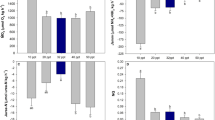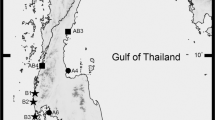Abstract
The effects of three environmental factors, salinity, carbonate alkalinity, and pH, on the survival, feeding, and respiratory metabolism of Eogammarus possjeticus (Amphipoda: Gammaridae) were investigated experimentally. The results show that E. possjeticus could tolerate a broad salinity range. The 24-h lowest median lethal salinity was 2.70, and the highest was 47.33. The 24-h median lethal alkalinity and pH were 23.05 mmol/L and 9.91, respectively; both values decreased gradually with time. Different values of salinity, carbonate alkalinity, and pH resulted in significant differences in the cumulative mortality (P<0.05). The ingestion rate and feed absorption efficiency were significantly affected by the coupling of the three environmental factors (P<0.05). With increases in carbonate alkalinity, salinity, and pH, both ingestion rate and feed absorption efficiency exhibited a downward trend, indicating a decline in feeding ability under high salinity and more alkaline water conditions. The coupling of salinity, carbonate alkalinity, and pH also had a significant effect on respiration and excretion (P<0.05). The oxygen consumption rate increased first and then decreased with increasing carbonate alkalinity. Under the same carbonate alkalinity values, the oxygen consumption rate increased with increasing salinity. Under the same carbonate alkalinity and salinity, the oxygen consumption rate initially increased and then decreased with increasing pH. The O:N ratio first increased and then decreased with increasing carbonate alkalinity. When carbonate alkalinity was less than 6 mmol/L, the O:N ratio increased with increasing salinity and decreased with increasing pH. The results demonstrate that changes in salinity, carbonate alkalinity, and pH had a measurable impact on the osmotic pressure equilibrium in E. possjeticus and affected the energy supply mode (i.e. ratio of metabolic substrate).
Similar content being viewed by others
References
Ananthi P, Santhanam P, Nandakumar R, Ananth S, Jothiraj K, Dinesh K S, Balaji P B, Jayalakshmi T. 2011. Production and utilization of marine copepods as live feed for larval rearing of tiger shrimp Penaeus monodon with special emphasis on astaxanthin enhancement. Indian Journal of Natural Sciences, 2: 494–503.
Baeza-Rojano E, Hachero-Cruzado I, Guerra-García J M. 2014. Nutritional analysis of freshwater and marine amphipods from the Strait of Gibraltar and potential aquaculture applications. Journal of Sea Research, 85: 29–36.
Cai Q J, He W H, Peng Z R, Li X X, Cui L X, Zhang A. 2017. Effects of pH and salinity on heart rate and feeding behavior of Daphnia magna. Journal of Shanghai Ocean University, 26(3): 415–421.(in Chinese with English abstract)
Cao S M, Song B, Wang L M, Sun K, Wang H Y. 2015. Effect of temperature, salinity and pH on respiration and excretion in gammarid Eogammarus sinensis. Journal of Dalian Ocean University, 30(5): 519–523.(in Chinese with English abstract)
Conover R J, Corner E D S. 1968. Respiration and nitrogen excretion by some marine zooplankton in relation to their life cycles. Journal of the Marine Biological Association of the United Kingdom, 48(1): 49–75.
Cunha M R, Sorbe J C, Bernades C. 1997. On the structure of the neritic suprabenthic communities from the Portuguese continental margin. Marine Ecology Progress Series, 157: 119–137.
Dauby P, Scailteur Y, De Broyer C. 2001. Trophic diversity within the eastern Weddell Sea amphipod community. Hydrobiologia, 443(1-3): 69–86.
Duffy J E, Hay M E. 2000. Strong impacts of grazing amphipods on the organization of a benthic community. Ecological Monographs, 70(2): 237–263.
Fang W H, Wang H, Lai Q F, Huang C N. 1999. Effect of K+, SO42- and HCO3-(CO32-) concentrations on the survival of Protosalanx hyalocranius larvae. Marine Fish eries, (2): 66–68.(in Chinese with English abstract)
Feng L, Wang J H, Tang X X. 2009. Study on feeding ecology of rotifer Brachionus urceus. Marine Environmental Science, 28(4): 349–354.(in Chinese with English abstract)
General Administration of Quality Supervision, Inspection and Quarantine of the People's Republic of China, Standardization Administration of the People's Republic of China. 2008. GB 17378.4-2007 The specification for marine monitoring, Part 4: seawater analysis. China Standard Press, Beijing. p.111-113.(in Chinese with English abstract)
Geng L W, Jiang H F, Xu W. 2017. Effects of carbonate alkalinity on oxygen consumption and ammonia excretion in bulimia barbel Barbus capito. Chinese Journal of Fisheries, 30(6): 30–33.(in Chinese with English abstract)
He Q, Chang Y M, Su B F, Sun B, Sun X W, Liang L Q. 2016. Effects of carbonate alkalinities on oxygen consumption, ammonia excretion and ammonia excretion gene expression in Leuciscus waleckii Dybowski. Journal of Shanghai Ocean University, 25(4): 551–558.(in Chinese with English abstract)
Huang N Y, Fan Q G, Gu X L, Xia L J. 2010. Diet composition of juvenile Siberian sturgeons( Acipenser baeri ) cultured in inland reservoir in western China and its' relations with benthic organism resources. Marine Fisheries, 32(3): 313–319.(in Chinese with English abstract)
Huang R, Xu F K. 2017. Study on the acute toxicity of rotenone to Lateolabrax japonicas and Chaeturichthys stigmatias Richardson. Transactions of Oceanology and Limnology, (1): 96–101.(in Chinese with English abstract)
Hwang P P, Lee T H. 2007. New insights into fish ion regulation and mitochondrion-rich cells. Comparative Biochemistry and Physiology Part A: Molecular & Integrative Physiology, 148(3): 479–497.
Ikeda T. 1974. Nutritional ecology of marine zooplankton. Memoirs of the Faculty of Fisheries, Hokkaido University, 22: 1–97.
Jaffer Y D, Saraswathy R, Ishfaq M, Antony J, Bundela D S, Sharma P C. 2020. Effect of low salinity on the growth and survival of juvenile pacific white shrimp, Penaeus vannamei: A revival. Aquaculture, 515: 734561.
Jiang H B, Bao J, Jiang C J, Fu P P, Yu Y H, Li X D. 2017. Effects of pH on survival and respiratory metabolism of Chinese Grass Shrimp( Palaemonetes sinensis ). Chinese Journal of Zoology, 52(2): 322–330. (in Chinese with English abstract)
Lin T T, Lai Q F, Yao Z L, Lu J X, Zhou K, Wang H. 2013. Combined effects of carbonate alkalinity and pH on survival, growth and haemocyte parameters of the Venus clam Cyclina sinensis. Fish and Shellfish Immunology, 35(2): 525–531.
Lv F, Huang J T, Wang A M. 2007. Effects of alkalinity on the food consumption, growth and survival of Allogynogemetic crucian carp. Journal of Anhui Agricultural Sciences, 35(22): 6789–6790.(in Chinese with English abstract)
Mayzaud P. 1976. Respiration and nitrogen excretion of zooplankton. IV. The influence of starvation on the metabolism and the biochemical composition of some species. Marine Biology, 37(1): 47–58.
Mueller L D, Ayala F J. 1981. Trade-off between r-selection and K-selection in Drosophila populations. Proceedings of the National Academy of Sciences, 78(2): 1303–1305.
Neuparth T, Costa F O, Costa M H. 2002. Effects of temperature and salinity on life history of the marine amphipod Gammars locusta. Implications for ecotoxicological testing. Ecotoxicology, 11(1): 61–73.
Normant M, Lamprecht I. 2006. Does scope for growth change as a result of salinity stress in the amphipod Gammarus oceanicus ? Journal of Experimental Marine Biology and Ecology, 334(1): 158–163.
Ruyet J P L, Mahé K, Le Bayon N, Le Delliou H. 2004. Effects of temperature on growth and metabolism in a Mediterranean population of European sea bass, Dicentrarchus labrax. Aquaculture, 237(1-4): 269–280.
Sainte-Marie B. 1992. Foraging of scavenging deep-sea lysianassoid amphipods. In: Rowe G T, Pariente V eds. Deep-Sea Food Chains and the Global Carbon Cycle. Springer, Dordrecht. p.105–124.
Savant K B, Amte G K. 1995. Influence of some environmental factors on respiratory responses in the tropical estuarine crab Ilyoplax gangetica. Journal of Environmental Biology, 16(4): 311–317.
Subida M D, Cunha M R, Moreira M H. 2005. Life history, reproduction, and production of Gammarus chevreuxi (Amphipoda:Gammaridae) in the Ria de Aveiro, northwestern Portugal. Journal of the North American Benthological Society, 24(1): 82–100.
Wang W N, Wang A L, Chen L, Liu Y, Sun R Y. 2002. Effects of pH on survival, phosphorus concentration, adenylate energy charge and Na + -K + ATPase activities of Penaeus chinensis Osbeck juveniles. Aquatic Toxicology, 60(1-2): 75–83.
Wu Y T, Lv G T, Ren S Y, Wang Z Z, Cao B. 2012. The effct of consumption rate and CAT, SOD enzyme activity from water temperature on Macrobrachium mipponensis. Journal of Zhejiang Ocean University( Natural Science ), 31(3): 197–201.(in Chinese with English abstract)
Xue S Y, Fang J G, Zhang J H, Jiang Z J, Mao Y Z, Zhao F Z. 2013. Effects of temperature and salinity on the development of the amphipod crustacean Eogammarus sinensis. Chinese Journal of Oceanology and Limnology, 31(5): 1010–1017.
Xue S Y, Mao Y Z, Li J Q, Zhu L X, Fang J G, Zhao F Z. 2018. Life history responses to variations in temperature by the marine amphipod Eogammarus possjeticus(Gammaridae) and their implications for productivity in aquaculture. Hydrobiologia, 814(1): 133–145.
Yang F Y, Sun L M, Yang X Q. 2004. Toxicity of carbonate alkalinity to Penaeus vannamei juveniles. Fisheries Science, 23(9): 3–6.(in Chinese with English abstract)
Yao Z L, Guo W F, Lai Q F, Shi J Q, Zhou K, Qi H F, Lin T T, Li Z N, Wang H. 2016. Gymnocypris przewalskii decreases cytosolic carbonic anhydrase expression to compensate for respiratory alkalosis and osmoregulation in the saline-alkaline Lake Qinghai. Journal of Comparative Physiology B, 186(1): 83–95.
Yao Z L, Lai Q F, Zhou K, Rizalita R E, Wang H. 2010. Developmental biology of medaka fish (Oryzias latipes) exposed to alkalinity stress. Journal of Applied Ichthyology, 26(3): 397–402.
Zhang L Z, Yang J H, Liu J Y, Zhuang P, Zhao F, Qu L. 2009. Effects of water temperature, salinity, pH, and anaesthetics on oxygen consumption rate of juvenile Siganus canaliculatus. Chinese Journal of Ecology, 28(8): 1494–1498.(in Chinese with English abstract)
Zhang T, Sun C B, Guan R L. 2012. Effect of multi-factors on energy metabolism of juvenile Litopenaeus vannamei. Journal of Tropical Organisms, 3(1): 11–15.(in Chinese with English abstract)
Zhao Y, Wu J W, Meng S, Wang Y, Wu H, Zhao J L. 2016. Effects of carbonate alkalinity on serum pH, ammonia concentration and related gene expression in Oreochromis niloticus. Journal of Southern Agriculture, 47(6): 1032–1038.(in Chinese with English abstract)
Zhou K, Lai Q F, Wang H, Huang N Y, Yao Z L. 2007. Acute toxicity effects of calcium and magnesium on larva of Litopenaeus vannamei. Marine Science s, 31(7): 4–7.(in Chinese with English abstract)
Author information
Authors and Affiliations
Corresponding author
Additional information
Supported by the Youth Talent Support Program of the Laboratory for Marine Ecology and Environmental Science, Pilot National Laboratory for Marine Science and Technology (Qingdao) (No. LMEESYTSP-2018-04-02), the Creative Team Project of the Laboratory for Marine Ecology and Environmental Science, Pilot National Laboratory for Marine Science and Technology (Qingdao) (No. LMEES-CTSP-2018-4), the Central Public-interest Scientific Institution Basal Research Fund, CAFS (No. 2020TD50), and the Central Public-interest Scientific Institution Basal Research Fund, YSFRI, CAFS (No. 20603022018003)
Rights and permissions
About this article
Cite this article
Xue, S., Mao, Y., Wang, J. et al. Effects of salinity, carbonate alkalinity, and pH on physiological indicators of nutrition transporter for potential habitat restoration of amphipod Eogammarus possjeticus. J. Ocean. Limnol. 38, 1925–1935 (2020). https://doi.org/10.1007/s00343-020-0063-0
Received:
Accepted:
Published:
Issue Date:
DOI: https://doi.org/10.1007/s00343-020-0063-0




